
We hope that each of you, our readers, will greatly enjoy and appreciate this article we present about these 5 Fully Fabulous Foxes. It was certainly our pleasure to gather the information for you. May it provide you with both education and increased awareness.
Certainly, these few species listed herein represent only a few of the amazing species of fox found around the world. It’s our belief, though, that they serve as excellent representations of the wonders found here. Check out some of our other articles for similar marvels.
Arctic Fox
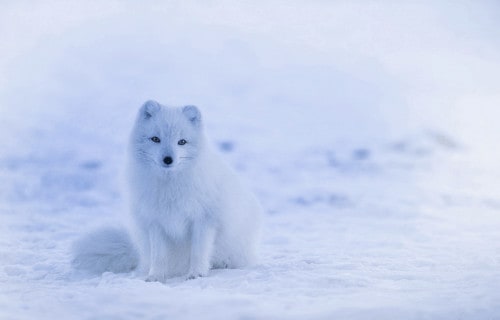
Arctic Fox Facts
- Leading off this article about these 5 Fully Fabulous Foxes we present to you the wonder of Nature known simply as the Arctic Fox.
- This magnificent mammal most frequently goes by the descriptive and informative common name we use here. The animal has several other general names, though. These include the titles of polar fox, snow fox, and the fully appropriate white fox.
- Within scientific circles, however, it’s better known by its technical name. Fortunately for the average layperson, that’s a relatively simple term, as such things go. That’s because this beautiful wild canine holds the short scientific name of Vulpes lagopus.
- It received that easy to pronounce name due to the efforts of the renowned Swedish zoologist, Carl Linnaeus. He achieved the first recorded acknowledgement of it as a separate and distinct species. He managed this scientifically noteworthy deed in 1758.
- It’s also renowned for several reasons. One is, of course, its sheer beauty. Another distinction it holds is the fact that it’s the only land mammal endemic to the country of Iceland. Four known subspecies of this wonder of Nature also currently exist.
- Despite the extreme harshness of its native habitat, the Arctic Fox seems to be in relatively good shape as a species. The stunning mammal appears to have a population base that’s both sufficient and stable. The IUCN thus presently lists it as Least Concern.
- Nevertheless, it must be considered to be facing at least some threats to its continued existence. Despite being legally protected in parts of its range, illegal hunting of it persists. It also now faces the same threat of ongoing climate change as all species do.
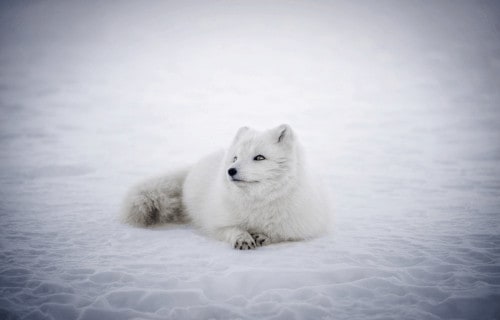
Arctic Fox Physical Description
The stunning Arctic Fox clearly impresses those fortunate to encounter one in the wild. That’s when they can even see it, given its incredible camouflage. The animal achieves that impression due more to its remarkable appearance than its sheer physical size.
That’s because, despite its other wondrous attributes, it’s only an average-sized variety of fox. It also follows another pattern common to its relatives. That’s true since this amazing animal displays the physiological characteristic known as sexual dimorphism.
In its case, this trait manifests itself in terms of pure physical size. More specifically, males attain a larger average body size than their female counterparts. That difference, however, ranks as comparatively minor. Otherwise, the two genders remain virtually indistinguishable.
The males of the species reach an average head-and-body length of approximately 22 in (55 cm). Exceptional specimens sometimes reach 27 in (68 cm). Females, meanwhile, grow to an average length equaling roughly 20 in (52 cm), excluding the tail, of course.
In both sexes of the Arctic Fox, the tail develops as relatively long. This appendage reaches an average length of 12 in (30 cm). The animal also grows to 9.8 – 11.8 in (25 – 30 cm) at the shoulder. Males average 7.7 lb (3.5 kg), while females average 6.4 lb (2.9 kg).
Yet its the mesmerizing coloring of the animal that garners the most attention. Although the young display dark colors, this changes quickly to a dazzling white as they mature. This shade covers the entirety of the body, all the way to the tip of the fluffy tail.
- Kingdom: Animalia
- Phylum: Chordata
- Class: Mammalia
- Order: Carnivora
- Family: Canidae
- Genus: Vulpes
- Species: V. lagopus

Arctic Fox Distribution, Habitat, and Ecology
The beautiful Arctic Fox evolved as native to a surprisingly large region of the world. As its very name implies, this includes the Arctic Circle. But it’s not restricted to that area, though. It appears in the more northern portions of Europe, Asia, and North America.
That range even includes such isolated areas as Iceland, Greenland, Svalbard, and other islands located in the Barents Sea. In Canada, it appears as far south as Hudson Bay. The animal was also previously introduced to the Aleutian Islands southwest of Alaska.
Its habitat consists almost exclusively of regions of Arctic tundra. It also favors sections of pack ice. The animal does manage to survive in a few other habitats, though. These mainly include boreal forests in such places as the Kenai Peninsula and several in Canada.
Within this type of environment, it also appears at a surprising range of altitudes. Many individuals live in regions of up to 9,800 ft (3,000 m) above sea level. Other specimens, though, have been spotted on collections of sea ice very close to the North Pole itself.
Protected by its warm, dense fur, the Arctic Fox evolved as a pure predator. It feeds opportunistically, consuming virtually any prey it finds. This prey typically includes such species as voles, lemmings, birds, hares, eggs, small fish, and even carrion when available.
Intriguingly, it has few natural predators itself, despite its relatively small size. The few creatures that do routinely prey on it include wolves, bears, and golden eagles in some parts of its range. In the wild, few live even one year, but some live as long as 11 years.
Island Fox
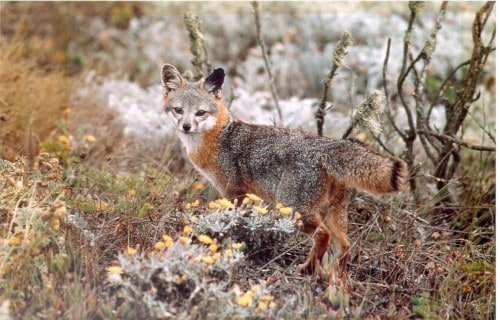
Island Fox Facts
- Next up in this composition about 5 Fully Fabulous Foxes comes the intriguing product of evolution known as the Island Fox.
- The term for it serves as the most often used common name for this intriguing member of the Canidae Family. It also goes by a variety of others. These include Coast Fox, Island Gray Fox, Channel Islands Fox, and Insular Gray Fox, among others.
- Among scientists, though, it’s typically referred to by its formal, technical name. Thankfully, that’s a relatively simple term, as such things go. That’s because this marvel of Nature and evolution holds the official moniker of the Urocyon littoralis.
- It received this name due to the efforts of the American researcher, Spencer Fullerton Baird. The respected naturalist made the first acknowledgement of the mammal as a separate and distinct species. He accomplished this noteworthy deed in 1857.
- It also holds a respectable position in the annals of science. This holds true due to the fact that a total of six known subspecies of the species also exist. Each of these subspecies additionally appears only in its own solitary, highly isolated habitat range.
- Four of those profit from federal protection. The Island Fox itself, however, does not. Presently, its population appears to be dwindling. That’s due to a combination of factors, both natural and artificial. The IUCN, therefore, lists it as Near Threatened.
- Most of the dangers it faces arise from human activities. These incluse such problems as introduced species, such as feral pigs. Others include diseases and parasites not native to its habitat. Its greatest threat, though, likely consists of climate change.
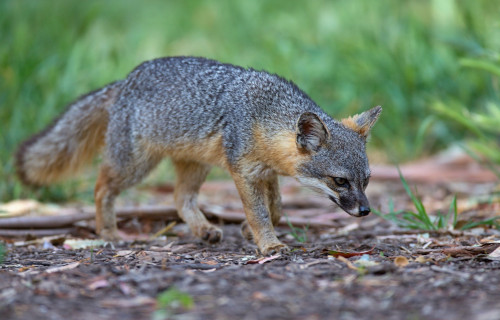
Island Fox Physical Description
The Island Fox easily draws the attention of those fortunate enough to encounter it. It’s worth noting, however, that it does so for reasons other than sheer size. That’s due to the fact that this fox qualifies as the smallest of all related species in its part of the world.
In terms of head-and-body length, mature adults average just 19.0 – 19.5 in (48 – 50 cm). The tail, though, varies significantly between individuals. This part of its body averages between 4.5 – 11. 5 in (11 – 29 cm). The reasons for such dramatic variations remains undetermined.
Its shoulder height leaves it small in stature. This varies, but averages 4.5 – 6 in (12 – 15 cm). It also displays the physiological characteristic of sexual dimorphism. In this case, the male attains a larger size than the female. Weights range from 2.2 – 6.2 lbs (1 – 2.8 kg).
It also strongly resembles its mainland cousin, the Gray Fox, in appearance. The greatest visual distinction between the two remains the length of the tail. The main source of that difference springs from the fact that the Island Fox has fewer vertebrae in that appendage.
Its pattern of coloring mainly differs in the degree of shading. That’s due to the fact that, generally speaking, this animal manifests a coat that’s slightly darker and duller than that close relative. The tail further distinguishes the two mammals in yet another manner.
This part of the body displays a black running most of its length. Its close relative lacks this distinctive marking. Otherwise, it manifests gray fur on its head, and a somewhat bright red on its sides. It additionally shows whitish fur on its throat, lower face, and stomach.
- Kingdom: Animalia
- Phylum: Chordata
- Class: Mammalia
- Order: Carnivora
- Family: Canidae
- Genus: Urocyon
- Species: U. littoralis
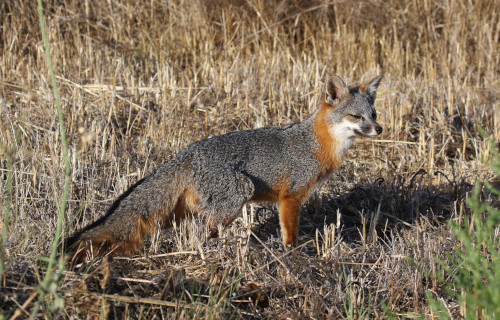
Island Fox Distribution, Habitat, and Ecology
The amazing Island Fox evolved as native to an overall region of the globe already renowned for its abundance of fabulous flora and fauna. That’s true since it developed as endemic to North America. Sadly, though, it only appeas in an extremely limited portion of it.
This marvel makes its home in a specific portion of the United States. That region’s further part of the state of California. To be specific, it lives on six of the eight islands comprising the Channel Islands of California. Evidence also indicates it never lived anywhere else.
In fact, each of the six subspecies appears on one island apiece. Both they, and the parent species, though, make the most of their situation. That’s because all of them live in every biomes present. These consist of temperate grassland, chaparral, and temperate forests.
Within these various regions, though, the animal displays a strong preference for one type of habitat. That’s partially formed by the presence of a complex layer of vegetation, such as grasses. Yet it also favors the presence of copious woody, perennial fruiting shrubs.
The Island Fox usually forms monogamous breeding pairs. It lives in dens, with the female giving birth to a litter of 1 -5 pups. These she bears in spring, with the young emerging in early summer. All live a principally nocturnal existence, with peaks at dusk and dawn.
Like its relatives, it evolved as a carnivore. Due to its size, however, it generally hunts smaller prey. This typically includes such creatures as lizards, crabs, birds, and small mammals, such as deer mice. It also occasionally supplements this diet with eggs, insects, and fruit.
Fennec Fox

Fennec Fox Facts
- The third species appearing in this listing of 5 Fully Fabulous Foxes, the Fennec Fox, places in that spot only due to random selection.
- This remarkable mammal most frequently goes by the deceptively simple common name due to cultural reasons. That term derives from the Arabic word fanak. For the moment, this small wonder of evolution has no other accepted general name.
- In scientific circles, though, it’s typically better known by its formal moniker. Fortunately for the layperso, that’s a term more easily pronounced than many. That’s because this intriguing wild canine bears the official name of the Vulpes zerda.
- The animal received that title due to the efforts of the respected German zoologist, Eberhardt August Wilhelm von Zimmermann. He accomplished the first recognition of it as a separate and distinct species. This important event occurred in 1780.
- Fortunately, the amazing Fennec Fox appears to be maintaing a populatio base that’s both sufficient and stable. This pleasant trend also seems to hold true throughout the entirety of its known range. The IUCN currently classifies the animal as Least Concern.
- Nevertheless, this fascinating creature faces several threats to its continued existence. In its native range, wild specimens are commonly trapped either for sale to toursits or for exhibition. It also now faces the same threat of climate change as all species.
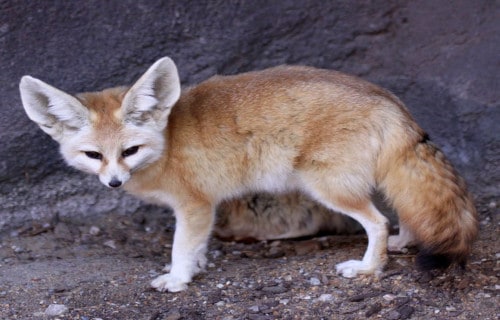
Fennec Fox Physical Description
The gorgeous Fennec Fox easily captivates most people fortunate enough to encounter it. Unlike some species, however, this occurs more due to its appearance than sheer size. That’s due to the fact that it represents the smallest of all known species of wild canines.
It does share a common trait with its many relatives, though. That’s true given the fact that it displays a certain degree of the physiological characteristic of sexual dimorphism. In its specific case, this trait manifests itself purely in terms of physical measurements.
More precisely, males attain a larger average size than their female counterparts. The difference remains relatively minor, though. With the exception of this trait, the two genders are virtually indistinguishable to the untrained eye. This often complicates identification.
The females of the visually impressive species reach an average head and body length of approximately 13.6 – 15.6 in (34.5 – 39.5 cm). Male specimens, meanwhile, grow to an average measurement equaling 15.4 – 15.6 in (39 – 39.5 cm) for the same physical structure.
Weights vary accordingly between the different sexes as well. Females typically weigh between 2.2 – 4.2 lb (1.0 – 1.9 kg). The males, however, tend to attain a slightly greater mass. The tail for both genders of the natural wonder averages roughly 9.1 – 9.8 in (23 – 25 cm).
The coat of the Fennec Fox typically presents a blending of creamy tan and white. The fur also has a fluffy nature, serving to help keep it warm at night. The ears represent its most recognizable feature. In ratio to body size, they’re the largest of all known wild canines.
- Kingdom: Animalia
- Phylum: Chordata
- Class: Mammalia
- Order: Carnivora
- Family: Canidae
- Genus: Vulpes
- Species: V. zerda
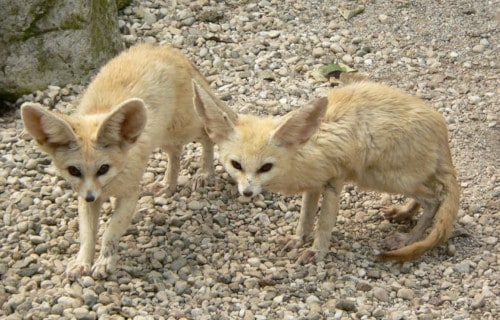
Fennec Fox Distribution, Habitat, and Ecology
The visual wonder that’s the Fennec Fox evolved as native to a respectable range of the globe. The location of that range, though, might surprise some people. That true since it remains endemic to portions of Africa, as well as a part of the Middle East.
In Africa, the lovely creature principally appears in portions of the Sahara. That extends from Mauritania to Morocco. From there, its range extends through Egypt. It even appears in sections of the Sanai Peninsula. Some specimens also live in the country of Israel.
Nature guided this animal through a very precise evolutionary path. It developed decidedly unexpected preferences in terms of its habitat. The animal primarily inhabits areas that most mammals, especially smaller ones, would scrupulously avoid at all costs.
It’s mainly a desert environment species. The mammal typically makes its home in small sands. Some, however, also live in various vast, treeless sandy areas with sparse vegetation. That flora generally consists of various species of sedges, grasses, and small shrubs.
The Fennec Fox developed a primarily nocturnal nature. It spends its days in its den, usually dug in the sand and located near patches of vegetation. The dens also appear highly organized, measuring as much as 1,291 sq ft (120 sq m), with up to 15 entrances and exits.
It also evolved as an omnivorous creature. Its diet principally consists of insects, rodents, eggs, and occasionally rabbits. It typically hunts by pouncing on its prey, leaping from a stationary position. Its own main predators consists of owls, jackals, and sometimes hyenas.
Gray Fox
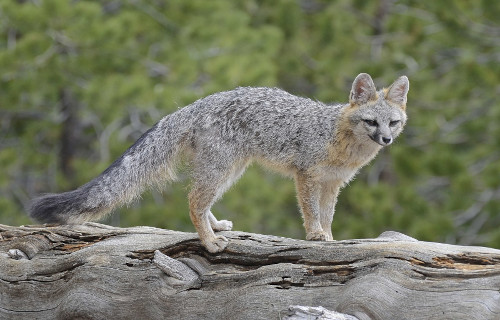
Gray Fox Facts
- Coming up next in this gathering of 5 Fully Fabulous Foxes we give you the appealing wild canine named the Gray Fox.
- This somewhat diminutive but still fascinating creation of Nature most frequently goes by the partially descriptive common name applied here. It also has several other alternates, though, These include the maned fox, tree fox, and common gray fox.
- Its formal name, however, is significantly harder to pronounce, perhaps even for experienced professionals. That’s because the official term applied to this marvelous mammal in the halls of science is the tongue-twisting term Urocyon cinereoargenteus.
- The visually distinctive species further received this appellation due to the work of the respected German naturalist, Johann Christian Daniel Schreber. He accomplished the first official recognition of the animal as a separate and distinct species, in 1775.
- Intriguingly, from a scientific standpoint, the creature represents one of only two members of its genus, Urocyon. Both it and the other member genetically represent the closest known surving species, out of all known canids, to a common ancestor.
- For the moment, the Gray Fox appears to be maintaining a population base that’s both stable and sufficient. The IUCN, therefore, currently lists it as Least Concern on its Red List. That holds true despite a reduced population in certain portions of its range.
- This marvel of Nature nevertheless faces some potential threats to its continued existence. Habitat loss, largely due to human encroachment naturally presents a problem. The greatest threat it faces, though, likely consists of ongoing climate change.
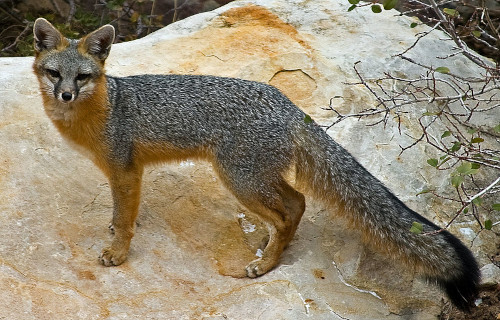
Gray Fox Physical Description
The magnificent animal most frequently known as the Gray Fox manages to pack all this awesomeness into a relatively small body. This merely serves to prove the point that physical size remains wholly irrelevant when considering the impressiveness of a species.
Unlike many of its relatives, however, this creature displays little noticeable degree of the physiological characteristic of sexual dimorphism. This fact further applies to both physical size, and color patterns. The precise reason for this, though, remains unknown.
Due to this, distinguishing the separate genders from a safe distance can be difficult, even for trained observors. The average adult, though, reaches a body length of between 19.1 – 26.9 in (48.5 – 78.2 cm). The long tail, though, adds an extra 10.8 – 17.4 in (27.5 – 44.3 cm).
The weight of individual specimens, however, tends to vary significantly. This often ranges from as little as 7.9 lb (3.6 kg), to as much as 15.4 lb (7 kg). Exceptional specimens do occur on occasion, though, These sometimes reach a weight of up to 20 lb (9.1 kg)!
The color pattern of the Gray Wolf presents a striking image to the viewer, as well. The upper parts typically present a grizzled pattern, with a black stripe extending to the end of the tail. It also manifests an off-white on the throat, chest, belly, hind legs, and ears.
- Kingdom: Animalia
- Phylum: Chordata
- Class: Mammalia
- Order: Carnivora
- Family: Canidae
- Genus: Urocyon
- Species: U. cinereoargenteus

Gray Fox Distribution, Habitat, and Ecology
Fortunately for the Gray Fox, as well as those of us who appreciate Nature, the canid evolved as native to a relatively large swathe of the globe. In fact, it’s actually the only known wild canid with a natural range that includes both North America and South America.
More precisely, however, the wild canine natively inhabits a range that extends as far north as the southern portions of the country of Canada. From there, that range extends through most of the United States, excluding the northwestern mountains of that country.
From there, its territory extends throughout Central America, and into the extreme northern portions of Venezuela and Colombia. In all portions of that range, though, it displays a decided preference for certain specific types of habitat in which to make its home.
The fascinating animal also displays a strong preference for regions consisting of wooded, rocky, bushy regions. In some small regions, it further manifests a strong fondness for regions of rocky bluffs possessing a dense covering of brush for its habitat.
Like most of its relatives, the Gray Fox evolved as a primarily nocturnal animal. It typically spends most of its days concealed in either burrows, hollow trees, or stumps. It’s also omnivorous, feeding on small prey, insects, and certain local plants, especially fruit.
In one manner, however, this extraordinary animal remains completely unique. That’s due to the incredible fact that it’s the only known canid to routinely climb trees! There, it often make sits home as high as 30 ft (9.1 m) up in the branches, and climbs like a cat.
Swift Fox

Swift Fox Facts
- Closing out this copendium of 5 Fully Fabulous Foxes is the remarkable mammal known by the name of the Swift Fox.
- The simple yet descriptive term it goes by serves as the commonly used name for a small variety of wild canine. In scientific circles, however, this remarkable mammal bears the name of Vulpes velox. By either term, though, it’s an important species.
- That fact may surprise some people, though, if they make assumptions based on size. That’s due to the fact that this animal represents the smallest of the wild dogs varieties native to its part of the world. Size, however, remains unimportant in Nature.
- Though long known to the Indigenous Peoples of the region, Captain Lewis of the Lewis and Clark expedition became the first known European to spot the animal. That first recorded encounter occurred on July 6, 1805, as noted in his journal.
- At that time, the marvelous mammal appeared in large numbers. Sadly, though, as settlers moved into its region, its numbers began to dwindle. By the 1930’s, it ranked as an endangered species, mainly due to control programs targeting coyotes and wolves.
- Thankfully, however, concerted reintroduction programs began in 1983. Since that time, its population appears to have rebounded successfully. The IUCN, therefore, currently lists the Swift Fox as Least Concern of its red List of Threatened Species.
- Yet, this status remains sensitive to various factors. For now, it only occupies about 40% of its original range. Habitat loss, due to continued human expansion, additionally remains a factor. Its greatest threat, though, no doubt consists of climate change.

Swift Fox Physical Description
While visually pleasing to those who appreciate wild canines, the Swift Fox does not garner that appreciation due to sheer size. Not only does it rank as the smallest wild canid in its part of the globe, in fact it qualifies as among the smallest of related species in the world.
Other than sheer size, it shares many traits with the other canids on the planet. Among those is the physiological principal of sexual dimorphism. In its particular case, the males of the species develop as larger than the females. The difference, though, remains quite minor.
Overall, the mammal averages a height of roughly 12 in (30 cm). In length, meanwhile, it typically reaches about 31 in (79 cm), from the head to the end of the tail. The weight of the animal, furthermore, generally only ranges from between 5 – 7 lb (2.3 – 3.2 kg).
In terms of appearance, the Swift Fox displays a pattern of colors that provides natural camouflage in its native environment. This typically consists of a fairly dark tan, almost grayish shade. It also usually presents a tannish yellow on its sides and the legs.
The rest of the body presents a different color pattern, though. Its chest, throat, and stomach typically present colors ranging from off-white to a pale yellow. Black patches also appear on its muzzle. Quite distinctively, the ears also develop as comparatively large.
- Kingdom: Animalia
- Phylum: Chordata
- Class: Mammalia
- Order: Carnivora
- Family: Canidae
- Genus: Vulpes
- Species: V. velox

Swift Fox Distribution, Habitat, and Ecology
Sadly, the beautiful Swift Fox once had a much more extensive range of habitation than it does today. That’s because it evolved as native to a relatively wide swathe of North America. In fact, that territory covered parts of two of the three countries on the continent.
More precisely, it lived from western Canada, through the Great Plains to Texas, in the United States. Unfortunately, it disappeared from Canada by 1938. Even though it’s since been reintroduced, its numbers remain few, appearing in scattered small groupings.
The endemic habitat of this marvelous small mammal consists of regions of deserts and shortgrass prairies. In these environments, its natural coloring allows it to blend in successfully, aiding its survival. There, the creature lives in dens it builds in sandy soil.
The common name of Swift Fox derives from the simple fact that this animal remains capable of impressive speeds. Individuals sometimes reach speeds in excess of 31 mph (50 kph). This both aids the species in hunting and evading its own natural predators.
In terms of dietary habits, it’s technically classified as a carnivore. This species actually feeds as an omnivore, however. It also tends to feed quite opportunistically. Mainly consuming meat, this small predator hunts and feeds on any small animals it can catch.
This diet most commonly includes such prey as small reptiles, birds, amphibians, fish, insects, and mammals. It does nonetheless consume small quantities of plant matter. Local grasses and berries sometimes serve as a supplement for this intrepid hunter.

5 Fully Fabulous Foxes
We hope that each of you thoroughly enjoyed reading, and hopefully learning from, this article we’ve written about these 5 Fully Fabulous Foxes. It’s also our hope that doing so has left you with either a new or renewed appreciation for such wonders of Nature.
Unfortunately, many other such creatures around the world now find themselves facing threats to their continued existence as a species. Many of those dangers, in fact, stem from the actions of mankind. We must do all we can to protect and preserve them all.
Check out our other articles on 4 Magnificent Birds of Mexico, Africa’s Many Geological Masterpieces, 7 Stunning Pacific Ocean Species, Fabulous Fungi Around the Globe









Leave a Reply